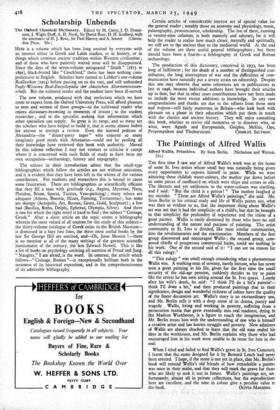The Paintings of Alfred Wallis
Alfred Wallis, Primitive. By Sven Berlin. (Nicholson and Watson. 21s.)
THE first time I saw any of Alfred Wallis's work was at the home of some St. Ives artists whose small boy was naturally being given every opportunity to express himself in paint. While we were admiring these childish water-colours, the mother put down before us some pieces of cardboard on which were ships and scenes in oils. The likeness and yet unlikeness to the water-colours was startling, and I said : " But the child is a genius! " The mother laughed at my mistake. " These are Alfred Wallis's paintings," she said. Mr. Sven Berlin in his critical study and life of Wallis points out, what was then so evident to us, that the important thing about Wallis's art was not that it had the simplicity of a child's, but that he brought to that simplicity the profundity of experience and the vision of a great painter. Wallis is easily dismissed by those who have no real understanding of the nature and purpose of painting. The artist community in St. Ives is divided, like most similar communities, into the revolutionaries and the reactionaries. Members of the first group discovered and encouraged Wallis ; the second group, com- posed chiefly of prosperous commercial hacks, could see nothing in his work. One of the second said of it : " I can see no reason for all this eulogy."
" This eulogy " was small enough considering what a phenomenon Wallis was. A working-man of seventy, barely literate, who has never seen a great painting in his life, given for the first time the small security of the old-age pension, suddenly decides to try to paint like the artists he has seen sitting around the St. Ives quays. Lonely after his wife's death, he said : " I think I'll do a bit'a paintin'— think I'll draw a bit," and then produced paintings that in their significance, design and wonderful richness of colour have the quality of the finest decorative art. Wallis's story is an extraordinary one, and Mr. Berlin tells it with a deep sense of its drama, poetry and tragedy. Wallis, living and working in poverty, suffering from a persecution mania that grew eventually into real madness, dying in the Madron Workhouse, is a figure to touch the imagination, and Mr. Berlin treats him with the understanding of one who is himself a creative artist and has known struggle and poverty. New admirers of Wallis are always shocked to learn that the old man ended his days in the workhouse, and Mr. Berlin explains why those who had encouraged him in his work were unable to do more for him in the end.
When I tried and failed to find Wallis's grave in St. Ives Cemetery, I learnt that th; stone designed for it by Bernard Leach had never been erected. I hope, if the stone is not yet in place, that Mr. Berlin's book will remind Wallis's old friends of how remarkable a painter was once in their midst, and that they will mark the grave for those who are likely to seek it out in future. Wallis's paintings are, un- fortunately, almost all in private collections, but the reproductions here are excellent, and the nine in colour give a peculiar value to














































 Previous page
Previous page